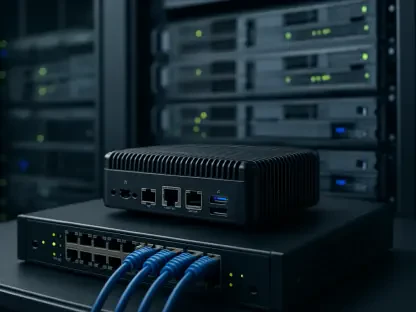In a tech landscape increasingly defined by connectivity and smart solutions, Synaptics Incorporated (NASDASYNA) has emerged as a pivotal player, delivering cutting-edge human interface technologies for diverse markets. The company’s Q4 fiscal 2025 earnings, released on August 7, unveiled a striking 55% year-over-year surge in Core IoT sales, underscoring its dominance in the Internet of Things space. With innovations spanning touch, voice, and vision interactions, Synaptics serves industries from consumer electronics to automotive interfaces. Yet, despite a revenue uptick to $282.8 million, a GAAP net loss of $4.7 million casts a shadow over these achievements. This dichotomy between explosive growth in key segments and persistent profitability hurdles raises critical questions about the sustainability of its aggressive expansion strategy. How is Synaptics navigating the balance between innovation-driven revenue and the financial weight of its ambitions?
The semiconductor firm operates under a fabless model, prioritizing design and development while outsourcing manufacturing, a strategy that has fueled breakthroughs in IoT and AI-enabled products. However, the costs of integrating recent acquisitions have proven substantial, with millions spent in Q4 alone on related expenses. As the company pushes into emerging fields like Edge AI, the tension between short-term financial strain and long-term market positioning becomes evident. This earnings report offers a window into not just numbers, but the broader challenges of scaling in a competitive, fast-evolving industry. What drives the IoT boom, and can Synaptics turn its operational wins into consistent bottom-line success?
Financial Performance and Profitability
Revenue Surge and Operational Strength
Synaptics reported a robust GAAP revenue of $282.8 million for Q4 fiscal 2025, reflecting a 14.3% increase compared to the previous year and edging past analyst expectations of $280.2 million. This growth was predominantly propelled by the Core IoT segment, which saw an impressive 55% year-over-year jump in sales, highlighting strong market demand for smart connected devices. Non-GAAP earnings per share came in at $1.01, narrowly surpassing forecasts of $1.00 and marking a significant 57.8% improvement from the prior year. Additionally, non-GAAP gross margins held steady at 53.5%, demonstrating operational efficiency across core business lines. This performance suggests that, on a non-GAAP basis, Synaptics is executing well, capitalizing on high-growth areas while maintaining cost discipline in its primary operations.
Beyond the headline revenue figures, the non-GAAP metrics point to a company with solid fundamentals in its day-to-day activities. The substantial improvement in earnings per share reflects not only revenue growth but also effective management of operational expenses in key segments. Stable gross margins further indicate that Synaptics has been able to maintain profitability in its core offerings despite market fluctuations. However, while these numbers paint a picture of strength, they stand in contrast to the challenges revealed by GAAP reporting. Investors looking at these results will likely appreciate the operational wins but remain cautious about the broader financial picture, especially as the company continues to invest heavily in future growth opportunities.
GAAP Challenges and Cost Burdens
On the GAAP front, Synaptics posted a net loss of $4.7 million, or $(0.12) per share, a sharp departure from the substantial profit recorded in the same quarter last year. This downturn is largely attributed to acquisition and integration-related costs amounting to $29.4 million for the quarter, which have significantly impacted overall profitability. These expenses, including amortization of intangibles and inventory adjustments, have dragged GAAP gross margins down to 43.0%, a notable decline compared to non-GAAP figures. The financial strain from these costs illustrates the high price of Synaptics’ strategy to expand through acquisitions, raising concerns about the timeline for achieving consistent GAAP profitability.
Delving deeper, the impact of these acquisition costs extends beyond a single quarter, with full-year expenses in this category reaching $97.5 million. This persistent burden suggests that while strategic moves are bolstering revenue in areas like IoT, they come at a steep upfront cost that erodes reported earnings. The disparity between GAAP and non-GAAP results highlights a critical tension in Synaptics’ approach: the pursuit of long-term market leadership versus short-term financial health. As the company navigates this balance, stakeholders will be watching closely to see if these investments yield sustainable returns or continue to weigh on the bottom line in the coming quarters.
Segment Dynamics and Market Trends
IoT Leadership and Product Innovation
The Core IoT segment stands as the cornerstone of Synaptics’ growth, with a remarkable 55% year-over-year sales increase in Q4 fiscal 2025, driven by innovative product launches and strategic acquisitions. Products like the Astra SR-series microcontrollers, designed for real-time AI computations at the edge, and low-power Wi-Fi 7 chips are meeting the rising demand for smart devices across consumer and industrial applications. Acquisitions, such as Broadcom’s visual sensing assets, have added nearly $10 million to quarterly revenue, enhancing Synaptics’ capabilities in emerging areas like augmented reality. This segment’s performance positions the company as a leader in the rapidly expanding IoT market, capitalizing on trends toward connectivity and intelligence in everyday devices.
Further strengthening its IoT dominance, Synaptics has adeptly integrated acquired technologies to broaden its product portfolio and market reach. The focus on edge intelligence—processing AI directly on devices rather than in the cloud—aligns with industry shifts toward faster, more efficient solutions. This strategic alignment not only drives revenue but also sets Synaptics apart from competitors still catching up to these trends. However, while IoT shines brightly, the heavy reliance on this segment for growth underscores a potential risk if market dynamics shift or competition intensifies. The challenge lies in sustaining this momentum while addressing vulnerabilities in other areas of the business.
Varied Performance Across Other Markets
Outside of IoT, Synaptics’ segments display a mixed bag of results, with enterprise PCs showing promising growth through AI-powered touchpads and human presence detection chips integrated into laptops. These innovations cater to the industry’s push for smarter, interactive devices, securing market share gains in a competitive space. The mobile segment also exhibits progress, particularly with touch controllers for foldable OLED displays targeting high-end Android smartphones, tapping into premium device trends. These developments indicate that Synaptics is carving out niches in evolving markets, leveraging its expertise in human interface solutions to meet modern consumer demands.
In stark contrast, the automotive segment continues to underperform, hampered by sluggish demand and slower adoption of advanced interface technologies in new vehicle models. This weakness mirrors broader industry challenges, including macroeconomic uncertainties and delays in integrating cutting-edge solutions into automotive designs. The disparity across segments reveals a lopsided growth story, with IoT carrying much of the revenue load while automotive lags behind. This uneven exposure raises questions about diversification and the company’s ability to mitigate risks tied to over-reliance on a single high-performing area. Balancing these dynamics will be crucial for long-term stability.
Strategic Moves and Future Outlook
Innovation Investments and Expansion Efforts
Synaptics’ commitment to staying at the forefront of technology is evident in its substantial $93.6 million investment in research and development during Q4 fiscal 2025, aimed at advancing products like edge AI microcontrollers and wireless connectivity solutions. This focus on innovation underpins the company’s strategy to lead in emerging fields critical to next-generation electronics. Strategic acquisitions, such as Broadcom’s GPS and visual sensing assets, are already contributing to revenue while opening new applications in consumer audio and augmented reality. Yet, these moves come with significant integration costs, posing a challenge to near-term profitability even as they enhance long-term competitive positioning.
Moreover, the company’s fabless model allows it to concentrate resources on design and system integration, fostering agility in a fast-paced market. This approach has enabled rapid development of products tailored to current trends, such as low-power chips for IoT devices. However, the financial burden of acquisitions and R&D spending necessitates a delicate balance between innovation and fiscal discipline. As Synaptics continues to push boundaries in AI-native devices, the success of these investments will depend on how quickly they translate into widespread market adoption and improved earnings, a key focus for stakeholders in the quarters ahead.
Capital Strategy and Forward Guidance
On the capital allocation front, Synaptics prioritized shareholder value through a $128 million share repurchase program in fiscal 2025, buying back nearly 5% of outstanding shares, with an additional $150 million authorized for future buybacks. This move signals confidence in the stock’s valuation, though cash reserves have dipped to $391.5 million, reflecting heavy spending on acquisitions and debt reduction. Gross debt was trimmed by 14% to $834.8 million, indicating efforts to manage leverage, but the decline in liquidity suggests a need for careful resource allocation as growth initiatives continue to demand significant funding.
Looking to Q1 fiscal 2026, Synaptics projects GAAP revenue of $290 million, plus or minus $10 million, representing about 13% growth year-over-year, with non-GAAP EPS forecasted at $1.05. However, a GAAP loss per share of $(0.54) is anticipated due to ongoing acquisition costs. Management remains optimistic, citing strong backlog and lean inventories as positive demand indicators, particularly in IoT. Yet, potential macroeconomic risks like supply chain issues linger on the horizon. The path forward will hinge on cost control, recovery in underperforming segments like automotive, and the ability to capitalize on design wins in high-growth areas, shaping the company’s trajectory in a competitive landscape.
Reflecting on Growth and Hurdles
Reflecting on Synaptics’ Q4 fiscal 2025 performance, the standout 55% growth in Core IoT sales underscored a company capitalizing on the surge in smart device demand, while strategic acquisitions amplified its market reach. However, the GAAP net loss of $4.7 million, driven by integration expenses, painted a sobering picture of the costs tied to such expansion. Segment disparities, with automotive trailing behind stronger areas like enterprise PCs, further highlighted the uneven nature of its portfolio. As Synaptics charted its course into fiscal 2026, the focus shifted to actionable steps: streamlining acquisition costs, bolstering weaker segments, and sustaining IoT momentum. Diversifying revenue streams beyond a single powerhouse segment emerged as a critical priority, alongside prudent financial management to rebuild cash reserves. These efforts, if executed well, could transform short-term challenges into a foundation for enduring success in the evolving semiconductor space.









